April 18: Tour along the shore and to Mr. Lee's home
by Mie
|
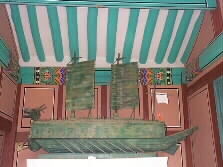
|
After the lunch, professor Lee kindly took us to a shore drive to a historic island called Han San Do. There is an old headquarter of an heroic admiral. In mid-15th century, Hideyoshi Toyotomi, the king of then Japan, invaded Korea twice. Korean navy led by Admiral Yi Sun-Shin responded back bravely, and by using an excellent tactic, they cut off the logistic line of the Japanese troops on the land and finally destroyed most Japanese invading fleet.
This is a replica of Korean warship called "Turtle battle ship." It features iron-clad armor with many thorns on the top and series of cannons on both side of the boat. The statues of Admiral Yi stand everywhere in the country still facing to Japan. I had once find it on the broad main street of Seoul.
|
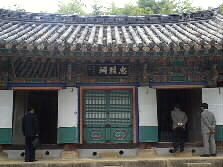
|
The mortuary tablet of Admiral Yi is set in this building called "The house of patriot" (built in 1606 in the headquarters in Tong Yong.) There are many camellia trees around the entrance of the temple.
|
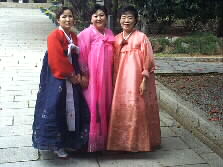
|
I came up with a couple of women wearing traditional clothing called "Chima Chogori." I asked then to take a picture.
|
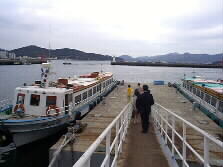
|
We got on a boat to visit the actual headquarters of Admiral Yi. The sea of this area is famous for its clear water, one of the best in the world. After 20 minutes' sail, we landed on Han Sang Do. The invader fleet of Hideyoshi Toyotomi was induced by a decoy boat of Korean navy and was completely destroyed by Admiral Yi in this waterway.
|
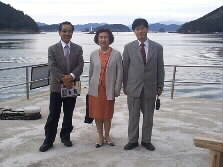
|
This is the pier of the island on which Admiral Yi set his headquarters. The island is kept very clean.
|
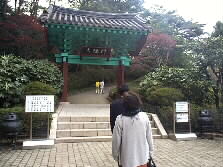
|
A beautiful trail leads us to the monument, passing under the cherry trees already turned to fresh green leaves. A beautiful gate painted in impressive green-based color welcomed us.
|
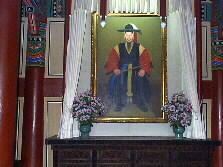 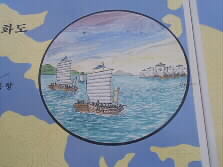
The painting of Admiral Yi Sun-Shin (left.) A detailed scene of the Sea battle (right.) Yi's fleet destroyed the invador, sinking many boats of Hideyoshi.
|

|
At the inlet of the bay is a lighthouse. The shape of the house is of a Turtle ship.
The sunset illuminated the inlet beautifully.
|
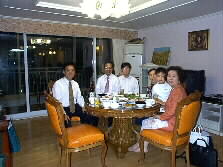
|
Then we hurried back to Masan to visit professor Lee's home. He kindly invited us for a dinner. It was already dark, Mr. Lee called his wife from the car every time at a stop signal.
His apartment is located in a new apartment complex in the suburbs of west Masan. There are many new buildings around the apartment. New school and new shopping centers are also located nearby.
His home is on the 4th floor of the 15 story building. The rooms are very spacious and clean. Lee Kyo Jin, eight year boy of the Lees, has been waiting for us late in the evening.
|
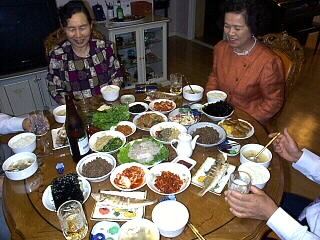 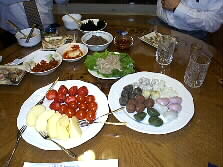
A luxurious dishes of Korean food fill the top of the table.
Professor Lee's mother-in-law, Ms. Mun Jong Ae who interpreted us at the presentation, and Mrs. Lee prepared all of the wonderful dishes, including home-made Kimuchi and soybean paste. Grilled fish and sashimi are among them. Fruits and sweet dumplings, containing really tasty jam, were served as the dessert. Every thing was so tasty, It was pity that I have so much eaten and had no room in my stomach to try all of the wonderful dishes.
|
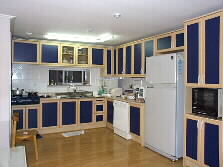 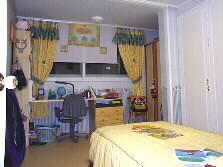
The clean spacious kitchen (left) with blue tone interiors. Mrs. Lee said they usually set the dinning table here. Son's room (left.) Mr. Matsumura, who have a boy of the same generation as Lee's, was moved to find a simple designed wooden table. I talked with Kyo Jin (son's name) by rotating a globe. His grandmother joined us and told her hard days after the war. She returned Korea and raised four children.
|
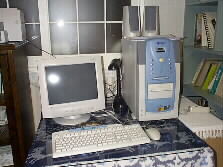 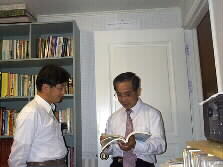
This is Professor Lee's reading room. His computer is not connected to the Internet, he said. He wants to connect the web from home for his wife's use, but she is very busy in teaching English in a high school and at the same time, she learns in a postgraduate course as well. She said she has no time to access to the web. Professor Lee (left) explains about his book to my husband Ken.
We hoped to talk much more, but it has already been too late in the night. We said good-bye to the families. Mr. Lee kindly sent us to the hotel. We really appreciate all of the families who extended their hospitalities over us.
|